50GI vs 50AE: Which One is Best for Your Needs?

Enthusiasts and professionals often find themselves debating over the merits of different calibers. This article will compare two popular handgun options: the .50GI vs 50AE. For this, we will explore their specifications, ballistics, stopping power, practicality, and pros and cons.
Gaining a deeper understanding of the .50 GI and .50 AE will enable you to select the ideal cartridge for your needs. Let us embark on this journey right now!
The 50 GI Caliber
The .50 GI is a powerful round used for sport shooting. Its availability and performance have made it a preferred choice for those seeking a formidable handgun caliber.
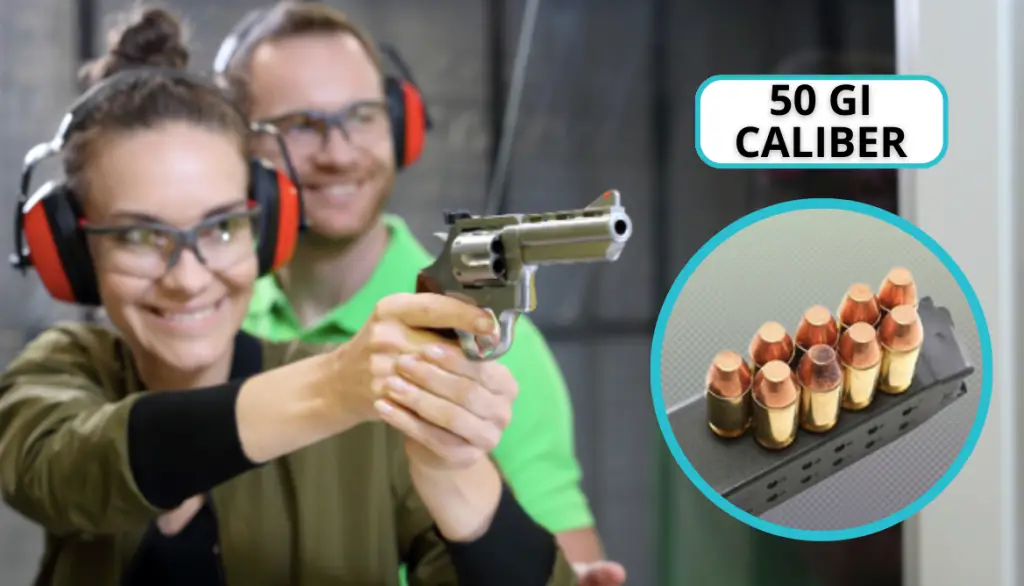
Here are some key facts about the 50 GI.
- It was developed in the early 2000s by Alex Zimmermann.
- The cartridge is primarily manufactured by Guncrafter Industries, a company based in the United States.
- The 50 GI caliber has a rebated rim based on a .45 ACP casing; this makes it compatible with other firearms chambered for that round.
The 50 AE Caliber
The .50 AE (Action Express) caliber is a powerful cartridge known for its considerable stopping power and ability to deliver devastating impact upon hitting the target.
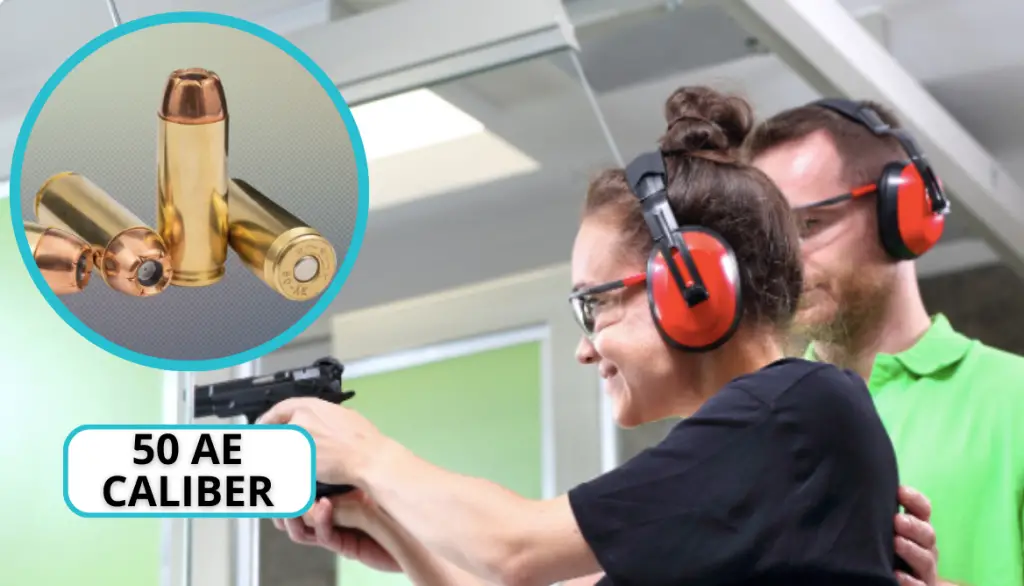
Key facts about the 50 AE:
- Evan Whildin of Action Arms developed it in 1988 specifically for the Desert Eagle semi-automatic pistol.
- The .50 AE is an effective round featuring a straight-walled case capable of delivering significant energy upon impact.
- The caliber gained popularity due to its effectiveness in penetrating body armor and stopping threats effectively.
- It is manufactured in Israel by Magnum Research, Magnum Research is known for its high-quality firearms, and the Desert Eagle chambered in .50 AE is one of their flagship offerings.
The 50GI Pros and Cons
50GI is known for its effectiveness in self-defense and hunting applications. Let’s explore its pros and cons:
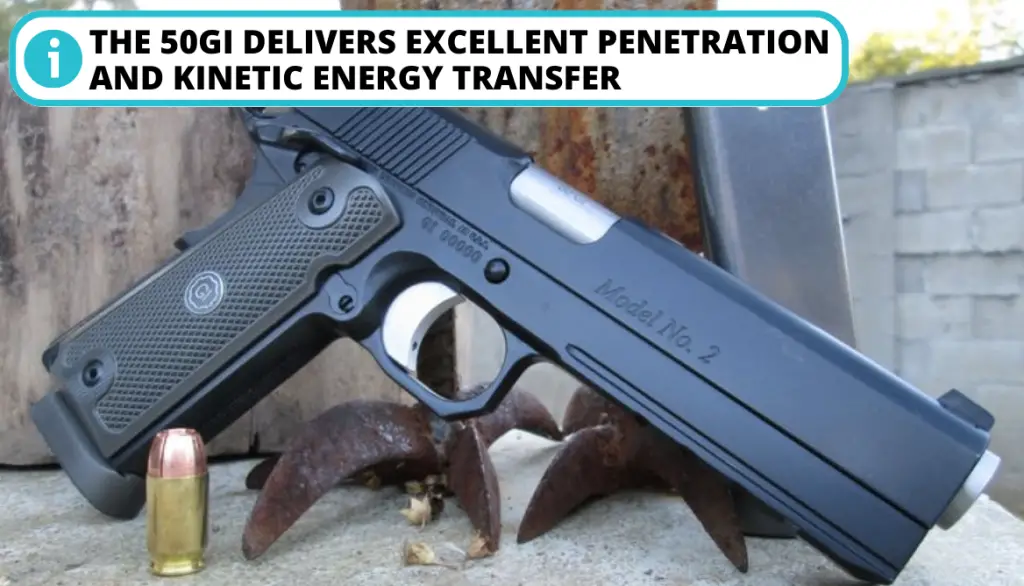
- The 50GI delivers excellent penetration and kinetic energy transfer.
- The 50 GI uses a heavier bullet, resulting in reduced energy transferred to the shooter upon firing the weapon.
- The GI offers a good balance between power and control, making it suitable for shooters who want significant stopping power with less recoil.
- The 50 GI has a longer barrel, allowing the bullets to rotate and stabilize for a longer duration while in the air hence offering enhanced overall accuracy.
- The 50GI is limited to Glock pistols chambered for it, which restricts the range of firearm options available for this cartridge.
- Limited availability compared to other more popular cartridges.
The 50 AE Pros and Cons
Now let’s take a quick look at the 50 AE upsides and downsides:
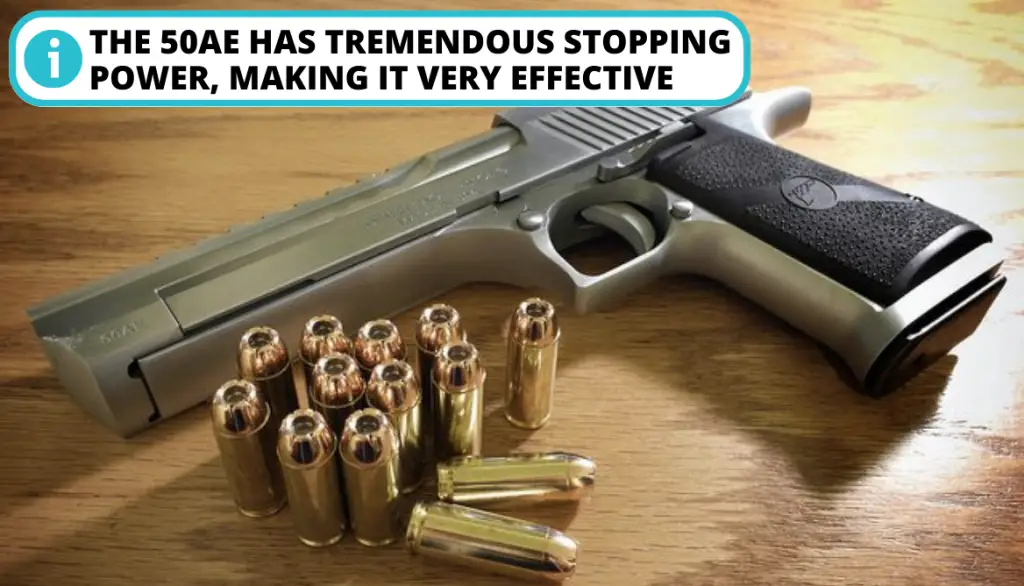
- The 50AE delivers immense stopping power, making it highly effective for self-defense and hunting scenarios.
- Versatile Firearm Options: The 50AE offers more choices for shooters.
- Ammunition Availability: Due to its popularity and longer-standing presence in the market, the 50AE generally benefits from a broader availability of ammunition options.
- Cheaper compared to the 50 GI.
- Reduced muzzle flash compared to the 50 GI due to the slower-burning powder.
- Size and Weight: Firearms chambered in 50AE tend to be larger and heavier, which may limit their practicality.
- The .50 AE is less accurate due to more recoil. Firearms equipped with sights may pose increased difficulty in handling and shooting.
- It has a shorter barrel, which gives the bullets less time to spin and stabilize in flight. This results in less consistent accuracy.
50GI vs 50AE: Key Differences
The 50GI and the 50AE are known for their power and performance. However, several differences set them apart. These features include size, stopping power, pricing, availability, and compatibility. Let’s check them out.
1. Size
The .50 GI and .50 AE have the same diameter of .500 inches (12.7 mm) but differ in other dimensions. Let us check out the important differences.
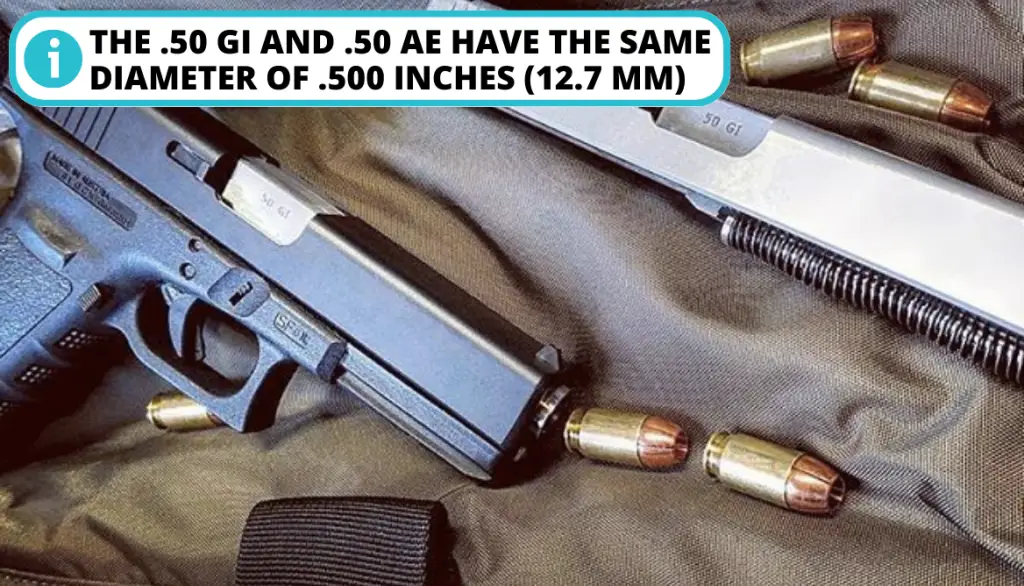
.50GI: Key Dimensions
Case type: | Rebated rim, straight |
Bullet diameter: | 0.5 Inches (1.27 cm) |
Neck diameter: | 0.526 Inches (1.34 cm) |
Base diameter: | 0.526 Inches (1.34 cm) |
Rim diameter: | 0.480 Inches (1.22 cm) |
Case length: | 0.899 in (2.28 cm) |
Overall length: | 1.221 in (3.10 cm) |
Maximum pressure: | 23,000 psi (110 MPa) |
The .50 AE: Key Dimensions
Case type: | Rebated rim, straight |
Bullet diameter: | 0.5 Inches (1.27 cm) |
Neck diameter: | 0.531 Inches (1.35 cm) |
Base diameter: | 0.543 Inches (1.38 cm) |
Rim diameter: | 0.514 In (1.31 cm) |
Case length: | 1.285 In (2.28 cm) |
Overall length: | 1.610 In (4.090 cm) |
Maximum pressure: | 23,000 psi (160 MPa) |
2. The 50 GI vs.50 AE: Stopping Power
The stopping power is the ability of a caliber to halt a target upon impact. It is affected by numerous factors, for instance: Bullet design, velocity, energy transfer, and shot placement. Both the .50 GI and .50 AE cartridges provide considerable stopping power, delivering large, heavy bullets that transfer significant kinetic energy.
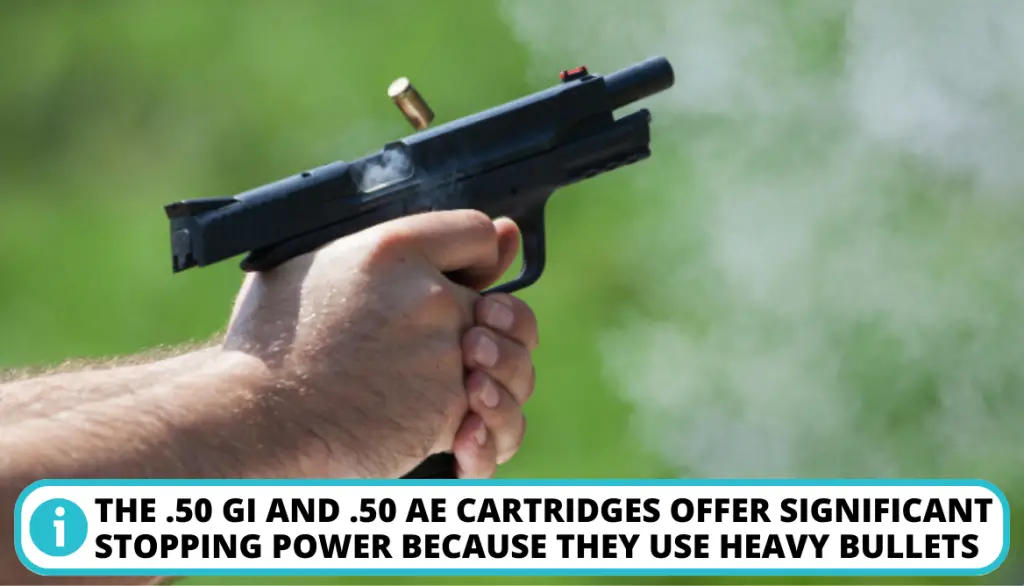
When comparing their stopping power, it is essential to consider the following features:
Muzzle Energy (300-grain bullet mass (19 g)
50 GI: | 1965 J |
50 AE: | 442 J |
Muzzle Velocity (300-grain bullet mass (19 g)
50 GI: | 450 m/s |
50 AE: | 210 m/s |
3. 50 GI Vs. 50 AE: Pricing
The prices of ammunition and firearms chambered in .50 GI and .50 AE varies depending on the brand, availability, and market demand.
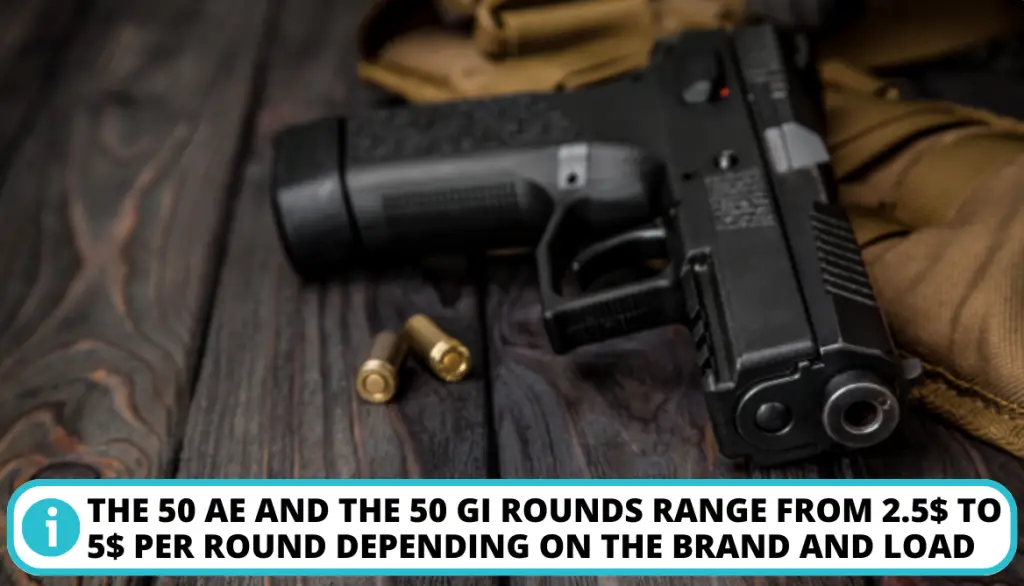
The 50 AE and the 50 GI rounds range from 2.5$ to 5$ per round depending on the brand and load.
- The .50 AE: This cartridge has been in production for a long and is widely available in the market, leading to a greater variety of manufacturers producing the .50 AE ammunition and resulting in more competitive prices. The cost of .50 AE ammunition usually ranges from $2.0 to $3.5 per round, depending on the brand and quantity.
- The 50 GI: the .50 GI cartridge is less common and has a narrower range of manufacturers compared to the .50 AE. Due to its relative scarcity and limited availability, .50 GI ammunition tends to be priced slightly higher than .50 AE.The cost of .50 GI ammunition ranges from $3 to $5 per round.
4. The 50 GI vs. 50 AE: Availability
The .50 AE cartridge is more readily available than the .50 GI cartridge due to the mass user adoption of the 50 AE on the Desert pistol.
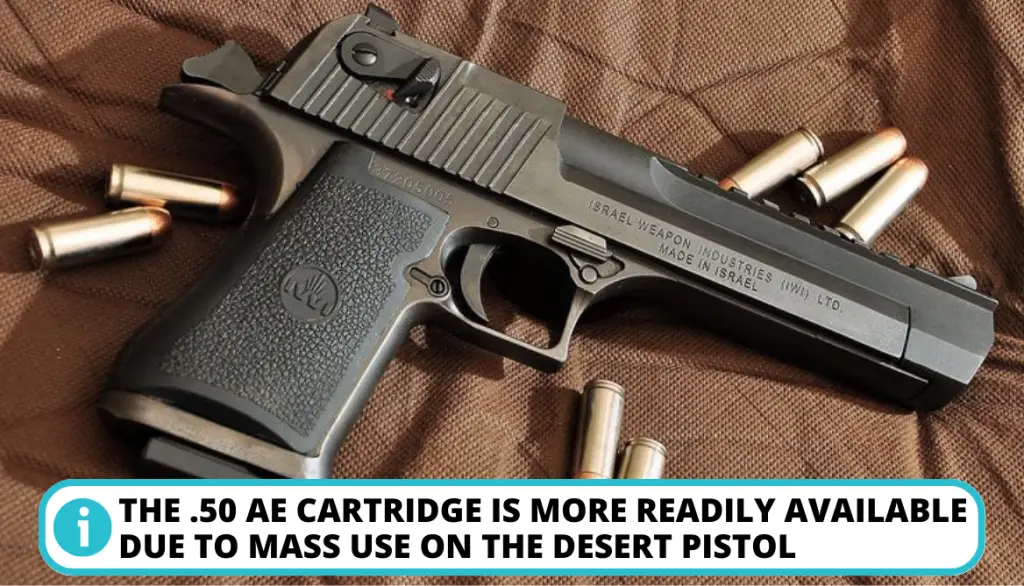
- 50 AE: The .50 AE is the most well-known and widely available cartridge. It is relatively easier to find in comparison to less common calibers.
- .50 GI: The .50 GI ammunition is produced by a limited number of manufacturers and may not be readily available at all stores or online retailers. However, you will still find it on specialty retailers, Glock, or licensed distributors.
5. The 50 GI vs.50 AE: Firearm Compatibility
The 50 GI and the 50 AE are two different cartridges that require specific firearms chambered for each cartridge. Here is a comparison of their firearm compatibility:
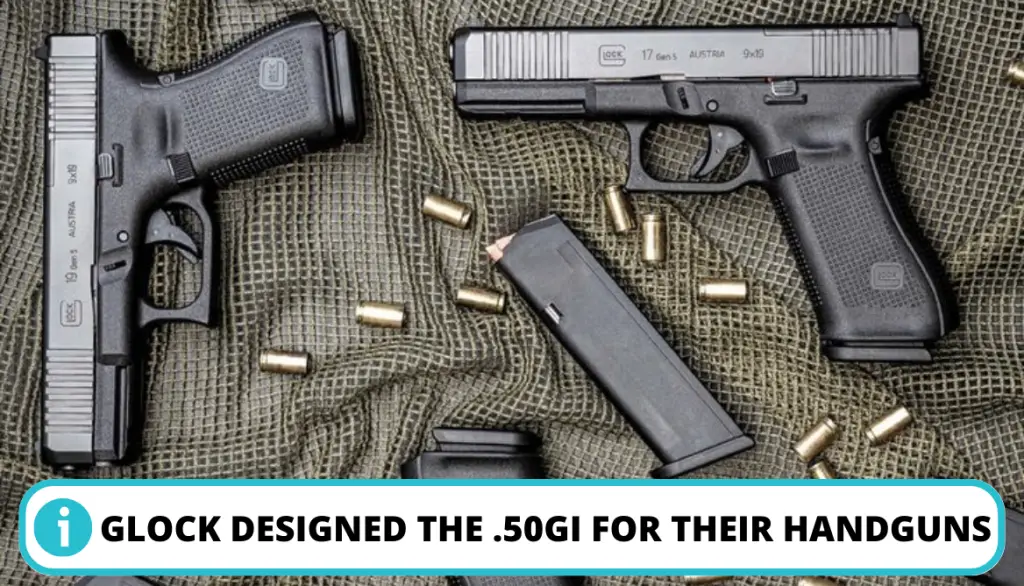
- 50 GI: Glock designed the .50GI for their handguns. Therefore, it is only compatible with Glock pistols chambered for the 50 GI cartridge. Examples include the Glock 20, Glock 21, and other models that accommodate the 50 GI cartridge.
- 50 AE: Magnum Research developed the .50 AE for their Desert Eagle pistol. While the Eagle is the most common firearm chambered for .50 AE, other guns on the market are chambered for this cartridge, though they are relatively rare compared to the Desert Eagle.
Neither cartridge is compatible with firearms chambered for the other cartridge, as they have different case dimensions, overall lengths, and pressure specifications.
6. The .50 GI Vs. 50 AE: The Most Powerful
The .50 GI and .50 AE cartridges are known for their substantial power and energy.

These cartridges find utility in self-defense, close-range game hunting, and as showpieces, owing to their impressive size and power.
Here are the power features that distinguish them:
Cartridges | Muzzle Velocity | Muzzle Energy | Maximum Pressure |
50 GI: | 210 m/s | 442 J | 23000 PSI |
50 AE: | 450 m/s | 1965 J | 36000 PSI |
The .50 GI vs. the .50 AE: Optimal Scenarios
Here are some scenarios where the 50 GI and the 50 AE cartridges are considered the best options:
- 50 GI: The balanced power and penetration make it the preferred choice for home defense, where the ability to stop threats quickly and effectively is crucial.
- 50 AE: The 50 AE is also perfect for hunting as it carries enough energy to deliver a lethal blow to medium game.

FAQ
What is the difference between 50 GI and 50 AE?
The 50GI cartridge is compatible with standard 1911-style pistols, whereas the 50AE cartridge was designed for the Desert Eagle pistol. Dimension-wise, the 50GI is shorter than the 50AE.
What is the difference between a 50 GI and a 45 ACP?
The primary difference between the 50 GI and the 45 ACP is the size. The 50 GI cartridge boasts a larger and more potent profile compared to the 45 ACP. Moreover, the 45 ACP enjoys a broader range of firearms chambered for it when contrasted with the 50 GI.
Is a .50 GI legal?
Yes, The GI is legal in most states and countries. However, California restricts the usage of high-caliber cartridges like the 50 GI. It is advisable to consult local firearms laws and regulations to determine the legality of owning and using a 50 GI cartridge in your area.
What is the recoil of a 50 GI round?
The recoil of a .50 GI round is 4.1 ft/lbs. Due to the large size and power of the cartridge, handguns chambered in .50 GI typically exhibit significant recoil when fired.
How much recoil does a 50 AE have?
The .50 AE exhibits a felt recoil of 5.0 ft/lbs, which can cause the muzzle to flip approximately 30 degrees when fired by a skilled shooter.
Conclusion
Our comparison of the 50GI and the 50AE has provided insights into the differences between these two cartridges. We have examined their specifications, ballistics, recoil control, availability of ammunition, and various applications.
Both cartridges offer substantial firepower, but the .50 AE cartridge stood out in terms of power, cost, availability, and compatibility with other firearms. The 50 GI is an excellent option if you are looking for a small cartridge with a less felt recoil.
Which factors do you prioritize when choosing a pistol cartridge for your shooting needs? Leave a comment below and let us know your perspective!
